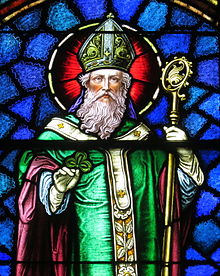 Global Information
Global InformationSaint Patrick information
Saint Patrick | |
|---|---|
 Stained-glass window of St. Patrick from Saint Patrick Catholic Church, Junction City, Ohio, United States | |
| |
| Born | Roman or sub-Roman Britain |
| Died | mid-fifth to early-sixth century Ireland |
| Venerated in |
|
| Major shrine |
|
| Feast | 17 March (Saint Patrick's Day) |
| Attributes | Crozier, mitre, holding a shamrock, carrying a cross, repelling serpents, harp |
| Patronage | Ireland, Nigeria, Montserrat, Archdiocese of New York, Roman Catholic Archdiocese of Newark, Roman Catholic Archdiocese of Los Angeles, Boston, Rolla, Missouri, Loíza, Puerto Rico, Murcia (Spain), Clann Giolla Phádraig, engineers, paralegals, Archdiocese of Melbourne; invoked against snakes, sins[1] |
Saint Patrick (Latin: Patricius; Irish: Pádraig [ˈpˠɑːɾˠɪɟ] or [ˈpˠaːd̪ˠɾˠəɟ]; Welsh: Padrig) was a fifth-century Romano-British Christian missionary and bishop in Ireland. Known as the "Apostle of Ireland", he is the primary patron saint of Ireland, the other patron saints being Brigid of Kildare and Columba. Patrick was never formally canonised,[2] having lived before the current laws of the Catholic Church in such matters. Nevertheless, he is venerated as a saint in the Catholic Church, the Lutheran Church, the Church of Ireland (part of the Anglican Communion), and in the Eastern Orthodox Church, where he is regarded as equal-to-the-apostles and Enlightener of Ireland.[3][4]
The dates of Patrick's life cannot be fixed with certainty, but there is general agreement that he was active as a missionary in Ireland during the fifth century. A recent biography[5] on Patrick shows a late fourth-century date for the saint is not impossible.[6] According to tradition dating from the early Middle Ages, Patrick was the first bishop of Armagh and Primate of Ireland, and is credited with bringing Christianity to Ireland, converting a pagan society in the process. He has been generally so regarded ever since, despite evidence of some earlier Christian presence.[7]
According to Patrick's autobiographical Confessio, when he was about sixteen, he was captured by Irish pirates from his home in Britain and taken as a slave to Ireland. He writes that he lived there for six years as an animal herder before escaping and returning to his family. After becoming a cleric, he returned to spread Christianity in northern and western Ireland. In later life, he served as a bishop, but little is known about where he worked. By the seventh century, he had already come to be revered as the patron saint of Ireland.
Saint Patrick's Day, considered his feast day, is observed on 17 March, the supposed date of his death. It is celebrated in Ireland and among the Irish diaspora as a religious and cultural holiday. In the dioceses of Ireland, it is both a solemnity and a holy day of obligation.
- ^ "Saints by Cause". Archived from the original on 10 August 2006. Retrieved 25 August 2006.
- ^ See Flechner 2019, p. 1
- ^ "Who Was St. Patrick?". History.com. 16 October 2023.
- ^ Ritschel, Chelsea; Michallon, Clémence (17 March 2022). "What is the meaning behind St Patrick's Day?". The Independent. Retrieved 17 March 2022.
The day of celebration, which marks the day of St Patrick's death, is a religious holiday meant to celebrate the arrival of Christianity in Ireland, and made official by the Catholic Church in the early 17th century. Observed by the Catholic Church, the Anglican Communion, the Eastern Orthodox Church, and the Lutheran Church, the day was typically observed with services, feasts and alcohol.
- ^ Saint Patrick Retold: The Legend and History of Ireland's Patron Saint. Princeton University Press. 2019. ISBN 9780691190013. Archived from the original on 11 June 2020. Retrieved 11 March 2019.
- ^ See Flechner 2019, pp. 34–35
- ^ "Who was Saint Patrick and why does he have a day?". National Geographic. 1 February 2019. Archived from the original on 5 March 2021. Retrieved 20 February 2023.